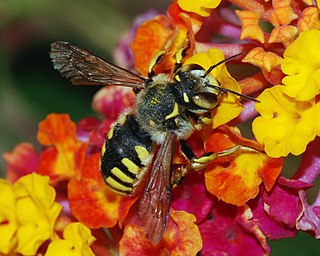
Megachilidae is a cosmopolitan family of mostly solitary bees whose pollen-carrying structure is restricted to the ventral surface of the abdomen. Megachilid genera are most commonly known as mason bees and leafcutter bees, reflecting the materials from which they build their nest cells ; a few collect plant or animal hairs and fibers, and are called carder bees, while others use plant resins in nest construction and are correspondingly called resin bees. All species feed on nectar and pollen, but a few are kleptoparasites, feeding on pollen collected by other megachilid bees. Parasitic species do not possess scopae. The motion of Megachilidae in the reproductive structures of flowers is energetic and swimming-like; this agitation releases large amounts of pollen.

Anthidium is a genus of bees often called carder or potter bees, who use conifer resin, plant hairs, mud, or a mix of them to build nests. They are in the family Megachilidae which is cosmopolitan in distribution and made up of species that are mostly solitary bees with pollen-carrying scopa that are only located on the ventral surface of the abdomen. Other bee families have the pollen-carrying structures on the hind legs. Typically species of Anthidium feed their brood on pollen and nectar from plants. Anthidium florentinum bees are distinguished from most of its relatives by yellow or brick-red thoracic bands. They fly all summer and make the nests in holes in the ground, walls or trees, with hairs plucked from plants.
Anthidium taschenbergi is a species of bee in the family Megachilidae, the leaf-cutter, carder, or mason bees.
Anthidium soni is a species of bee in the family Megachilidae, the leaf-cutter, carder, or mason bees.
Anthidium severini is a species of bee in the family Megachilidae, the leaf-cutter, carder, or mason bees.
Anthidium rotundum is a species of bee in the family Megachilidae, the leaf-cutter, carder, or mason bees.
Anthidium pontis is a species of bee in the family Megachilidae, the leaf-cutter, carder, or mason bees.

Anthidium oblongatum is a species of bee in the family Megachilidae, the leaf-cutter, carder, or mason bees.
Anthidium helianthinum is a species of bee in the family Megachilidae, the leaf-cutter, carder, or mason bees.
Anthidium gussakovskiji is a species of bee in the family Megachilidae, the leaf-cutter, carder, or mason bees.
Anthidium funereum is a species of bee in the family Megachilidae, the leaf-cutter, carder, or mason bees.
Anthidium eremicum is a species of bee in the family Megachilidae, the leaf-cutter, carder, or mason bees.
Anthidium emarginatum is a species of bee in the family Megachilidae, the leaf-cutter, carder, or mason bees.
Anthidium cordiforme is a species of bee in the family Megachilidae, the leaf-cutter, carder, or mason bees.
Anthidium collectum is a species of bee in the family Megachilidae, the leaf-cutter, carder, or mason bees.
Anthidium bischoffi is a species of bee in the family Megachilidae, the leaf-cutter, carder, or mason bees.
Anthidium bechualandicum is a species of bee in the family Megachilidae, the leaf-cutter, carder, or mason bees.
Anthidium tesselatum is a species of bee in the family Megachilidae, the leaf-cutter, carder, or mason bees.

Anthidiini is a tribe of insects in the family Megachilidae. There are at least 40 genera and 840 described species in Anthidiini.



